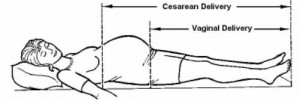a. Analgesics (Narcotics and Nonnarcotics).
Analgesics refer to a technique or medication that reduces or eliminates pain. A narcotic analgesic produces the same amount of CNS depression in the fetus as that produced in the mother. Analgesics are the most common form used in obstetrics today. They include:
(1) Demerol®–narcotic.
(2) Morphine®–narcotic.
(3) Stadol®–nonnarcotic.
(4) Nubain®–narcotic.
(5) Nisentil®–narcotic.
Brookside Associates Notes: Since this course was originally written…
1. Nisentil® (alphaprodine) was withdrawn from the market.
2. Dilaudid® (hydromorphone) is now frequently used in labor whenever a narcotic is needed.
b. Anesthetic.
Anesthetic refers to a technique or medication that partially or completely eliminates sensation or feeling. There are two types of nerve-blocking anesthetics, local and regional. Local anesthetics block sensory nerve pathways at the organ level. Regional anesthetics block sensory nerve pathways along the course of tissues. Refer to figure 4-3 for the level of anesthesia necessary for cesarean and vaginal delivery.

c. Sedative or Tranquilizer.
This refers to a medication that relieves anxiety and quiets the patient. It may combine with analgesics to enhance the effects of analgesics (although that effect is now being questioned). The primary ones for obstetrics are:
(1) Phenergan®–given more for its antiemetic effect.
NOTE: Antiemetic refers to preventing or alleviating nausea and vomiting.
(2) Vistaril®.
(3) Largon®.
